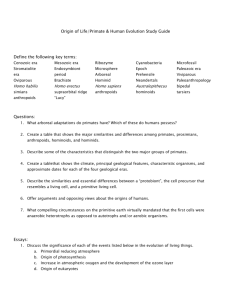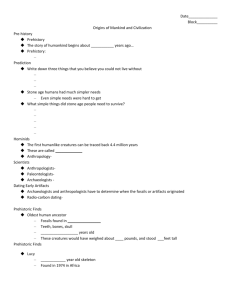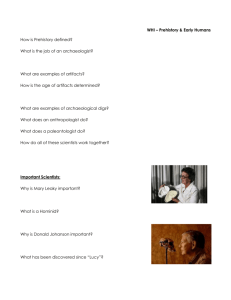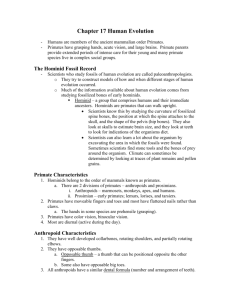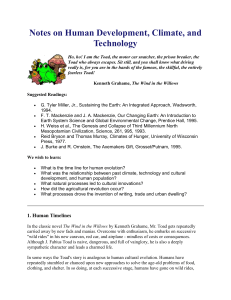Human Evolution Mini-unit Outline/Study Sheet Test Date
advertisement
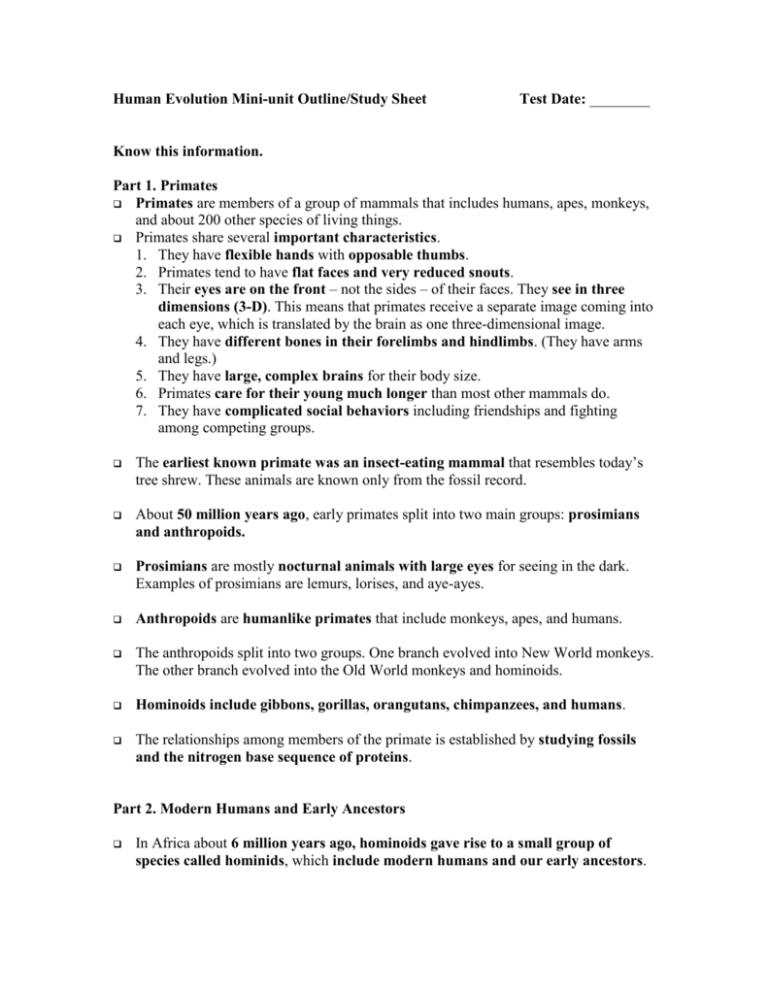
Human Evolution Mini-unit Outline/Study Sheet Test Date: ________ Know this information. Part 1. Primates Primates are members of a group of mammals that includes humans, apes, monkeys, and about 200 other species of living things. Primates share several important characteristics. 1. They have flexible hands with opposable thumbs. 2. Primates tend to have flat faces and very reduced snouts. 3. Their eyes are on the front – not the sides – of their faces. They see in three dimensions (3-D). This means that primates receive a separate image coming into each eye, which is translated by the brain as one three-dimensional image. 4. They have different bones in their forelimbs and hindlimbs. (They have arms and legs.) 5. They have large, complex brains for their body size. 6. Primates care for their young much longer than most other mammals do. 7. They have complicated social behaviors including friendships and fighting among competing groups. The earliest known primate was an insect-eating mammal that resembles today’s tree shrew. These animals are known only from the fossil record. About 50 million years ago, early primates split into two main groups: prosimians and anthropoids. Prosimians are mostly nocturnal animals with large eyes for seeing in the dark. Examples of prosimians are lemurs, lorises, and aye-ayes. Anthropoids are humanlike primates that include monkeys, apes, and humans. The anthropoids split into two groups. One branch evolved into New World monkeys. The other branch evolved into the Old World monkeys and hominoids. Hominoids include gibbons, gorillas, orangutans, chimpanzees, and humans. The relationships among members of the primate is established by studying fossils and the nitrogen base sequence of proteins. Part 2. Modern Humans and Early Ancestors In Africa about 6 million years ago, hominoids gave rise to a small group of species called hominids, which include modern humans and our early ancestors. Early hominids experienced changes in their spinal column and their hip and leg bones. The spinal column began to curve. Hips became smaller. The femur angled in from the body. These changes enabled them to walk upright. Walking upright is called bipedalism. An advantage to being bipedal is freedom to carry things and use tools. The first recognized hominids were the Australopithecines. They were short – not much larger than a modern day chimpanzee. The bones of their fingers were curved. Their brains were about the same size as a chimp’s, but they were bipedal. Lucy, an Australopithecus afarensis, is the most complete early fossil of a hominid ever found. Lucy lived between 2 and 3 million years ago. The first species to be placed in the genus Homo was Homo habilis. Habilis means skillful. Homo habilis is the first hominid to be associated with making tools. H.habilis could use fire but probably could not make fire. Homo habilis had a larger brain than any of the Australopithecines. Homo habilis lived about 2 to 1.8 million years ago. Homo habilis was followed by Homo erectus. Erectus means upright. H. erectus is associated with making fire. H. erectus is also the first of the hominids to leave Africa. Homo erectus lived about 1.5 million years ago. The first species of hominid to resemble modern humans is Homo sapiens neanderthalensis. Neanderthals lived during an ice age. They were short, robust hominids. They made complex stone tools and had large brains. They were very muscular. Many of their skeletal remains show evidence of a hard life. They buried their dead and added flowers and artifacts to the grave. They took care of their old and wounded family members. Neanderthals lived about 150,000 years ago. The first fossils of modern humans date to about 40,000 years ago. These humans, called Cro-Magnons, are designated as Homo sapiens sapiens. Modern Homo sapiens are associated with developing language, culture, art, and music. Their tools were much more complex and varied than those of the Neanderthals. In addition to the information above, be able to recognize artifacts associated with some of the hominid species. Be able to identify some major characteristics of their skulls.



